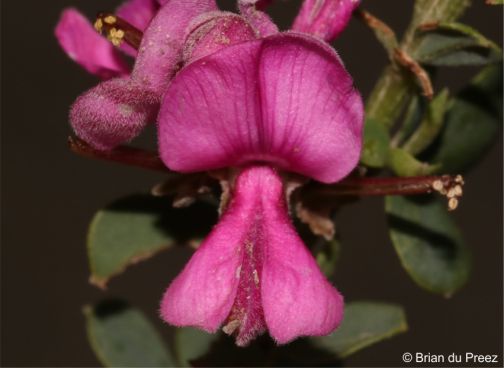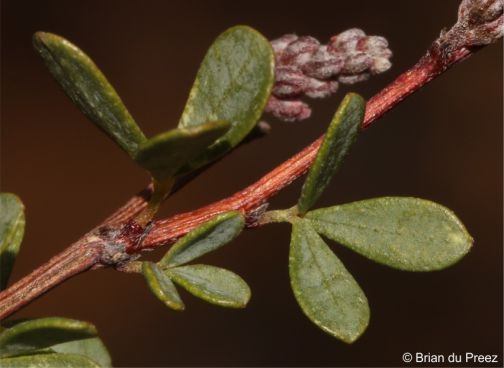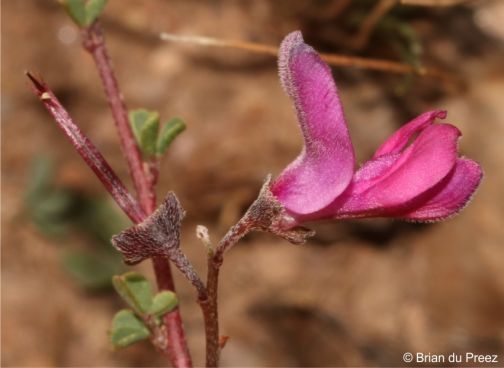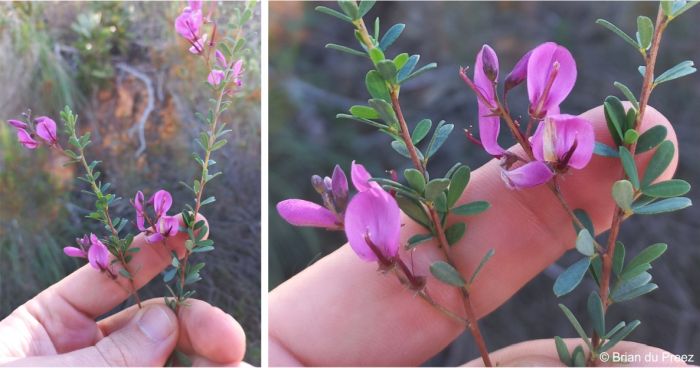Indigofera denudata
Indigofera denudata L.f.
Family: Fabaceae
Common names: denuded indigo (Eng.)
Introduction
Indigofera denudata is a striking shrub that produces an abundance of pink-magenta flowers throughout the year, with most flowers in autumn and spring.

Description
Description
Indigofera denudata is a spreading, low-growing to erect, resprouting, woody shrub up to 2 m tall, with hairless, greenish-brown becoming grey branches that are not spine-tipped. Leaves are pinnately or digitately trifoliolate, sometimes simple, with a 1–5.5 mm long petiole and oblanceolate, obovate to ovate, 4–22 × 2–17 mm leaflets. It has unscented, 7–9 mm long flowers, with 6–8 mm long stamens, and a pink-magenta corolla. Flowers are presented in racemes up to 50 mm long, consisting of 5–50 flowers, borne throughout the year with peaks in autumn and spring. The fruits are 25–40 × 3–3.5 mm, cylindrical, dark brown when mature, with 5-7 spherical-rectangular, 2.5 × 2 mm seeds per fruit.

Conservation Status
Status
This species is assessed as Least Concern (LC) in the Red List of South African Plants because it is common and widespread, and it meets none of the criteria for a threatened status.
Distribution and habitat
Distribution description
Indigofera denudata’s range extends from Mossel Bay through the Langkloof and Baviaanskloof, through the Albany Division, and the Steytlerville Karoo. This species can be found in a wide range of edaphic environments, including semi-arid mountains and valleys in the northwest of its range, subtropical thicket, and temperate lowland Fynbos. Vegetation types that I. denudata occurs in are Fynbos, Grassland and Albany Thicket, and it is often found growing in the transition zone between these vegetation types. It has been found to occur on sandstone, shale and soils formed from conglomerate, among other geologies.

Derivation of name and historical aspects
History
Indigofera is a widespread genus with over 700 species and is the third largest genus in Fabaceae. The name Indigofera translates to ‘bearing indigo’ referring to the blue dye produced by some species, where indigo is the dye and fero is the Latin word meaning ‘to bear’. This blue pigment has been referred to as indikon by the Greeks, meaning ‘a product from India’ with the English translation of this term being ‘indigo’. The specific epithet denudata translates to ‘denuded’ or ‘barren’ and could possibly be referring to the glabrous (hairless) surface of the leaves.

Ecology
Ecology
Indigofera denudata is a resprouter, which is a survival strategy that many species have in response to fire or other disturbance. Like many resprouters in Fynbos, Indigofera has adapted this strategy to ensure the survival of the plant after a fire, which frequently occur in Fynbos. When a fire occurs, most of the plant is destroyed but the rootstock, which is found underground, is usually still intact. From this rootstock new shoots emerge and the plant continues its life history.

Uses
Use
There are no recorded cultural and medicinal uses for this species however, many other species from this genus have recorded uses. Some are used in the production of indigo dye, some as a pasture legume and some are used for crop shading, soil protection, green humus covering, erosion control and as ornamental plants. There is also a long history of some of them having medicinal uses as some species are used to treat diseases, swellings and wounds.

Growing Indigofera denudata
Grow
Not much is known about growing Indigofera denudata only that according to Loddiges, when it was cultivated in a greenhouse, it grew best in light loamy soil with a moderate water supply and plenty of fresh air, with extra care in winter. It grows well in full sun, in well-drained soil that has a pH of 7.0 to 8.0. It can mostly likely be propagated by seeds or cuttings, as are other species in the Fabaceae, however, propagating via seeds seems to be more successful than from cuttings when looking at the propagation of other Indigofera species.
Sow seeds in autumn, or in spring or summer, depending on whether seeds are sown indoors or outdoors. Plant the seeds in containers with only a thin layer of soil covering them, making sure the seeds are just below the surface. After sowing, lightly wet the soil. Place the containers in a warm area that gets plenty of sunlight but is not in direct sun, and keep them moist. The germination is successful when a long, thin stalk with 2 opposite leaves is produced. Transplant the seedlings into individual pots after the first pair of true leaves appear, taking care not to damage the roots.
For propagation using semi-hardwood cuttings, select a healthy plant that does not have flowers or flower buds. Make a clean, straight cut when cutting off the side shoots from the parent plant. Treat the cuttings with a suitable rooting gel or hormone powder. Make a hole for each of your cuttings and add the appropriate amount of potting medium to a clean container. Plant the cuttings gently and firmly in place. Place in a warm, dry, well-ventilated, well-lit area away from direct sun. Keep damp and repot when appropriate.
Indigofera plants don’t have any known significant pest or disease issues.
References
- Chauhan, V. & Pandey, A.K. 2014. Structure and evolution of the pod in Indigofera (Fabaceae) reveals a trend towards small thin indehiscent pods. Botanical Journal of the Linnean Society 176: 260-276.
- Department of Agriculture, Land Reform and Rural Development. https://www.dalrrd.gov.za/phocadownloadpap/Brochures and_Production_Guidelines/. Accessed on 2023/10/18.
- Du Preez, B., Schrire, B.D., Dreyer, L.L., Stirton, C.H., Chimphango, S.B.M. & Muasya, A.M. 2023. Revision of Indigofera section Oligophyllae (Fabaceae: Indigofera) from South Africa. South African Journal of Botany 159: 544-562.
- Gerometta, E., Grondin, I., Smadja, J., Frederich, M. & Gauvin-Bialecki, A. 2020. A review of traditional uses, phytochemistry and pharmacology of the genus Indigofera. Journal of Ethnopharmacology 253: 112608.
- How to grow and care for indigo plants. https://gardenerspath.com/plants/flowers/grow-indigo/. Accessed on 2023/10/10.
- Loddiges, C. 1820. The botanical cabinet consisting of coloured celineations of plants from all countries. Vol. V. John & Arthur Arch,John Hatchard, Rodwell & Martinand C. Loddiges & Sons, London.
- Raimondo, D., Von Staden, L., Foden, W., Victor, J.E., Helme, N.A., Turner, R.C., Kamundi, D.A. & Manyama, P.A. (eds) 2009. Red list of South African plants. Strelitzia 25. South African National Biodiversity Institute, Pretoria.
- Wild colours, Indigo history. http://wildcolours.co.uk/html/Indigo_history.html. Accessed on 2023/3/30.
Credits
Samkelisiwe Mathonsi & Aarifah Jakoet
Compton Herbarium
February 2024
Acknowledgements: the authors thank Brian du Preez for the images.
Plant Attributes:
Plant Type: Shrub
SA Distribution: Eastern Cape, Western Cape
Soil type: Sandy, Loam
Flowering season: Spring, Autumn, Sporadic/All year
PH: Acid, Neutral
Flower colour: Pink
Aspect: Full Sun
Gardening skill: Average
Special Features:
Horticultural zones









Rate this article
Article well written and informative
Rate this plant
Is this an interesting plant?
Login to add your Comment
Back to topNot registered yet? Click here to register.